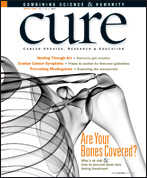Publication
Article
CURE
Finding the Clues
Author(s):
A survivor’s age delayed her diagnosis of Ewing’s sarcoma.
“I was 26 years old—you’re invincible, you don’t get cancer, young adults don’t get cancer,” quips Heidi Adams, 40, a 14-year Ewing’s sarcoma survivor, who now far better understands the reasons for the delays and mistakes of her initial diagnosis.
Although about 65,000 young adults in their 20s and 30s are diagnosed with cancer each year, according to the Lance Armstrong Foundation, Adams’ age—mid-20s at the time— worked against her at first. Ewing’s sarcoma is a rare and aggressive bone cancer that most often strikes younger adults and children, so Adams was initially diagnosed with phlebitis and subperiosteal hematoma. Nine months passed from first feeling extreme pain in her left ankle, which woke her up at night, until her eventual, correct diagnosis.
Age and cancer trends had tilted against her. But after 14 months of chemotherapy and six weeks of radiation, she recovered and went on to start Planet Cancer (www.planetcancer.org), a young adult advocacy and support group. “I didn’t know then what I know now,” Adams says, “that [tens of thousands of] people between 15 and 40 are diagnosed with cancer every year.” Perhaps neither did her doctors.
In Ewing’s sarcoma, as with other solid tumors, such as breast, colon, lung, or prostate, wide variations and new discoveries in genetic and cellular makeup of tumor tissue are changing the diagnostic landscape. The key advances in diagnoses occur when doctors shift their thinking away from what it looks like or what it feels like to what it acts like, biologically speaking.
Cytogenetics and gene array testing allow doctors and pathologists to essentially drill down and describe different subtypes of a tumor based on specific behaviors of individual gene proteins. (Gene array testing also leads to targeted cancer drugs, which are usually less toxic than traditional systemic chemotherapy.)
So, it’s not “just” breast cancer any longer. It’s breast cancer marked by hormone receptors, the HER2 protein, or genetic mutations, each of which, in turn, calls for an individualized treatment regimen to achieve best results.






